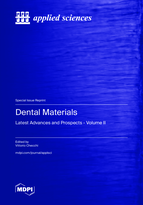Dental Materials: Latest Advances and Prospects - Volume II
A special issue of Applied Sciences (ISSN 2076-3417). This special issue belongs to the section "Applied Dentistry and Oral Sciences".
Deadline for manuscript submissions: closed (31 May 2023) | Viewed by 24360
Special Issue Editor
Interests: restorative dentistry; adhesive dentistry; dental materials; implant dentistry; biomaterials; periodontology; dental hygiene
Special Issues, Collections and Topics in MDPI journals
Special Issue Information
Dear Colleagues,
Following the success achieved with the first edition of the Special Issue “Dental Materials: Latest Advances and Prospects” in 2021, we have decided to create a second one, in order to continue to publish scientific research that reflects the state of the art in the field of dental materials.
Almost all fields of dentistry are closely related to newly developed materials, and all clinical improvements often follow or, in any case, always go hand in hand with the creation and development of innovative and higher-performing materials, instruments, and equipment. Thanks to the application of contemporary dental materials, the effectiveness of clinical dentistry has gained remarkable advances.
In recent years, thanks to digital technology and to the frenetic development of the dental industry, new materials have been developed and proposed in each field of dentistry: prosthesis, restorative dentistry, endodontics, implantology, and orthodontics. Unfortunately, as often happens, this productive challenge is not always accompanied by valid scientific research; consequently, the clinician finds at his disposal materials that are not necessarily better than the previous ones. Further studies are needed to gain relevant evidence for all recently introduced dental materials.
This Special Issue calls for high-quality research articles, clinical studies, review articles, and case reports focused on the latest advances and prospects of dental materials concerning all fields of dentistry.
Prof. Dr. Vittorio Checchi
Guest Editor
Manuscript Submission Information
Manuscripts should be submitted online at www.mdpi.com by registering and logging in to this website. Once you are registered, click here to go to the submission form. Manuscripts can be submitted until the deadline. All submissions that pass pre-check are peer-reviewed. Accepted papers will be published continuously in the journal (as soon as accepted) and will be listed together on the special issue website. Research articles, review articles as well as short communications are invited. For planned papers, a title and short abstract (about 100 words) can be sent to the Editorial Office for announcement on this website.
Submitted manuscripts should not have been published previously, nor be under consideration for publication elsewhere (except conference proceedings papers). All manuscripts are thoroughly refereed through a single-blind peer-review process. A guide for authors and other relevant information for submission of manuscripts is available on the Instructions for Authors page. Applied Sciences is an international peer-reviewed open access semimonthly journal published by MDPI.
Please visit the Instructions for Authors page before submitting a manuscript. The Article Processing Charge (APC) for publication in this open access journal is 2400 CHF (Swiss Francs). Submitted papers should be well formatted and use good English. Authors may use MDPI's English editing service prior to publication or during author revisions.
Keywords
- dental materials, dental adhesion
- ceramics and prosthetic materials, CAD/CAM related materials
- dental implants, biomaterials and materials for bone regeneration
- materials for endodontics
- materials for orthodontics






